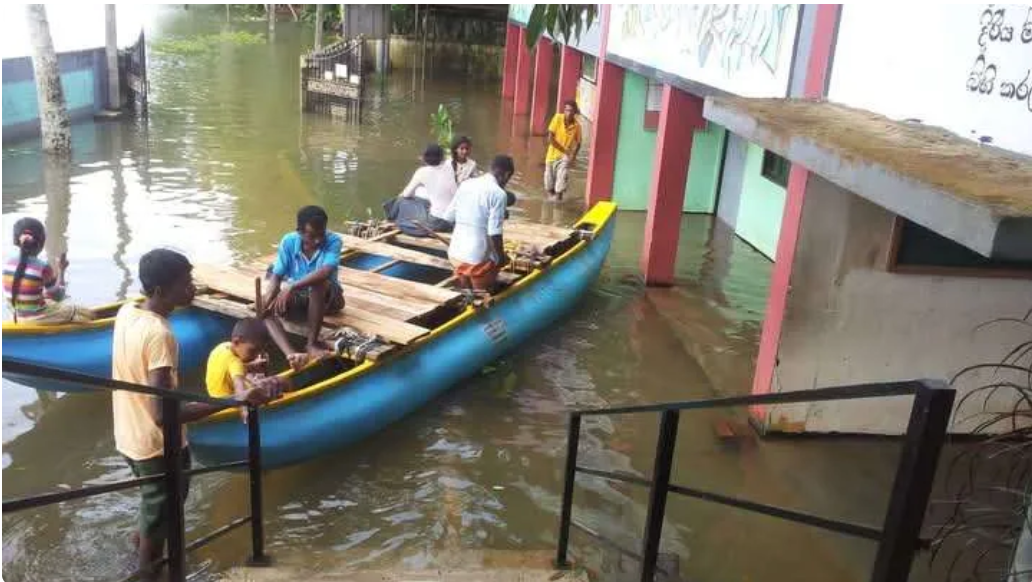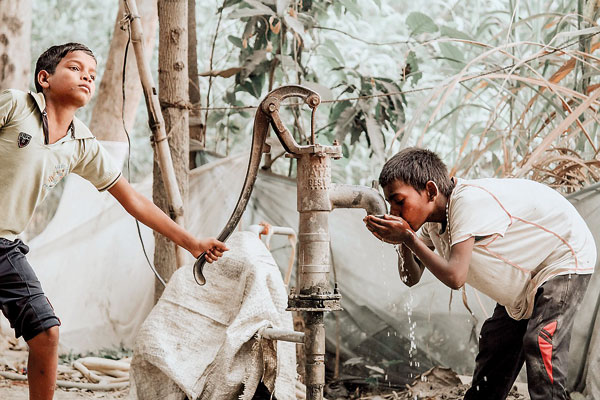BY Buddhika Samaraweera
- Climate change-related weather events prove to be an increasing challenge for most districts of Sri Lanka including Kalutara
The rain poured down heavily, turning narrow roads into muddy streams. Ten-year-old Dineth held his mother’s hand tightly as they watched the water rise near their home in Agalawatta in Kalutara. His schoolbag, packed and ready, lay untouched by the door. “No school today,” his mother sighed. It was not the first time. Every time the floods came, Dineth and his friends stayed home, missing lessons, exams, and the joy of being with schoolmates.
Rain is no longer just a minor disturbance for the Kalutara District; it has become a force severely impacting the residents’ lives. Floods submerge homes, schools, and livelihoods several times a year, leaving in their wake, much more than material losses. Friends and neighbours, once a community of support, are now scattered as families scramble, looking for safe dwellings during regular flooding events. With floods occurring a few times each year, community bonds are at risk, as is children’s education.
The 2018 Global Climate Risk Index report, first highlighted the extent of Sri Lanka’s vulnerability to climate change, identifying the island as one of the highly affected countries with regard to extreme weather events. It assessed the impacts of extreme weather for two decades, from 1998 to 2017.
With a population of around 22 million, Sri Lanka’s population grows at an annual rate of 1.1%. According to experts from several sectors, nearly 50% of the population is highly vulnerable to climate change-related impacts, particularly flash floods.
A closer look at the Kalutara District, which has a notably wet climate with abundant precipitation – recording over 2,880 millimetres (mm) of rainfall per year – reveals its vulnerability to climate change.
The first Biennial Transparency Report of Sri Lanka’s Climate Secretariat, which was submitted to the United Nations Framework Convention on Climate Change last year (2024), identified changing rainfall trends in Sri Lanka. It noted increasingly erratic rainfall due to climate change, with both South-West and North-East monsoons showing variability that results in excessive rainfall or extended dry spells.
The 17 experts who prepared the report identified the doubling of flash floods in the Kalutara District since 1990, attributed to the increased intensity of inter-monsoon rains. They also anticipate a 5-10% decrease in the annual rainfall in the dry zones and an increase in extreme rainfall events in the wet zones, to which the Kalutara District belongs, by 2030.
Kalutara’s increasing vulnerability
The Kalutara District’s rainfall trends support concerns raised in the said report, showing how extreme weather is already shaping its future.
‘Spatial Variability of Rainfall Trends in Sri Lanka as an Indication of Climate Change’, a research published in the International Journal of Geo-Information further highlights the island’s climate related vulnerabilities. A researcher with the International Water Management Institute with a focus on remote sensing and disaster risk Niranga Alahacoon, and a Professor in Engineering Physics at the Department of Physics, University of Colombo Mahesh Edirisinghe, have examined the spatial variability of rainfall trends in Sri Lanka from 1989 to 2019.
The study highlights the considerable increase in annual rainfall across all climatic zones – wet, dry, intermediate, and semi-arid. The wet zone recorded the highest increase in rainfall, while the semi-arid zone recorded the least. This suggests that Districts in the wet zone are at a higher risk of floods. During the considered period, the Kalutara District recorded the highest average annual rainfall of 3,340.2 mm including the highest maximum annual rainfall of 4,489.4 mm in 2019.
A trend analysis conducted by them using Kendall’s tau value – a non-parametric measure of the strength and direction of a monotonic relationship between two ranked variables – and Sen’s slope – a non-parametric method to estimate the slope of a trend line – shows that while rainfall has generally increased across all Districts between 1989 and 2019, Kalutara recorded the highest annual rainfall, with an increase of 34.84 mm per year. Further analysis of the Southwest monsoon rainfall trends showed a significant rainfall increase in seven wet zone districts – Kalutara, Colombo, Gampaha, Galle, Matara, Ratnapura, and Kegalle. Kalutara recorded the highest rainfall during the Southwest monsoon, increasing at 21.943 mm per year.
The Meteorology Department Director Anusha Warnasooriya, who holds a Doctor of Philosophy degree in climate studies, told The Daily Morning: “Rainfall in Sri Lanka is increasing. Our average annual rainfall typically ranges between 1,800 mm and 1,900 mm. In recent years, including 2024, it has exceeded 2,000 mm. The variability of rain is also high. For example, in 2024, rain has been heavier than predicted, with increased intensity, sometimes delivering a month’s worth of rain in just two days. Such extreme events are becoming more frequent due to climate change.”
The rising trend of extreme rainfall in Kalutara is not merely statistical; it is a reality that impacts the residents’ lives each year. As scientific studies highlight the steady increase in rainfall, disaster records show the human cost of these extreme weather events.
Statistics from the National Disaster Relief Services Centre (NDRSC) from 2016 to 2024 show repeated flooding incidents in Kalutara impacting 148,580 families (582,489 individuals) and being responsible for 40 reported deaths. In 2016, floods impacted 4,563 families (16,458 people) and killed six. The following year (2017), the situation worsened, with 48,889 families (183,835 people) being affected, with 17 fatalities. The subsequent year 2018 saw 7,438 families (28,876 individuals) impacted with no lives lost.
In contrast, 2019 marked the worst year, with 61,301 families (255,964 people) affected with one reported death. In 2020, the floods impacted 1,599 families (6,255 people), killing two. In 2021, 4,318 families (16,482 people) were affected, and five lives were lost. The floods slightly receded in 2022, affecting 1,759 families (6,817 individuals) with one fatality. In 2023, 2,430 families (8,971 people) were affected, with two deaths reported. In 2024, floods once again tore through communities, forcing 16,283 families (58,831 individuals) to flee their homes and claimed six lives.
Disaster prone
A resident of the Kithulgoda Grama Niladhari Division in the Kalutara District, Ashoka Swarnalatha recalls the loss of her neighbours in a 2017 landslide. The family next door – a mother, father, and daughter – was buried when the floods triggered a collapse. “I’ve been living here for over 50 years. When I was young, flooding wasn’t a problem. But now, it rains almost every day. Small streams we played in as children have turned into raging waters that overflow. That year, the rain didn’t stop, and my neighbours were gone in seconds in a landslide. We were like one family. We cooked together, shared food, and looked out for each other.”
Pathma Priyanthika used to live in Ihala-Kudaligama, a village where her family had lived for over 80 years. It was a place untouched by floods or landslides, even in the days of their grandparents. In 2014, two families, including theirs, had to flee, fearing the risk of rain-induced landslides. The house that formed their family’s foundation for generations was no longer safe. Now, living 20 kilometres away, they have lost touch with childhood friends, relatives, and neighbours. She says: “It was a lifetime of memories that we had to leave. We left everything familiar, from the trees that we planted as children to the neighbours who felt like family. Our children had friends there, a school that they loved, and a place that they belonged to. Now, they struggle to adjust in a new place. Our business, which we built with so much effort, had to be rebuilt from scratch.”
Meanwhile, Disaster Management Centre (DMC) Director – Awareness Pradeep Kodippili said that the relevant authorities including the DMC are currently working to develop early warning systems related to natural disasters including floods, and to strengthen social welfare systems to support vulnerable populations. He says that there are plans to reduce morbidity and mortality from extreme weather events by establishing warning systems using the latest technology, carrying out timely risk assessments, and improving health preparedness.
Disruption to school education
According to the Education Ministry, the Kalutara District has 419 schools, including 50 in Category 1AB (Grades One-13 or Six-13 with all three curriculum streams for the General Certificate of Education [GCE] Advanced Level [A/L]), 66 in Category 1C (Grades One-13 or Six-13 without the science stream for A/L), 162 in Category Two (classes up to the GCE Ordinary Level), and 141 in Category Three (Grades One-Five or One-Eight). Frequent flooding in the District severely impacts students, teachers, and parents, with unavoidable school closures due to floods disrupting education.
The Kudaligama Maha Vidyalaya, located in the Bulathsinhala Divisional Secretariat Division of Kalutara, is one of the many schools that face disruptions due to flooding. Every year, the school is forced to close for nearly five days when heavy rains make it impossible for students and teachers to attend. In 2024, apart from the regular holidays announced by the Education Ministry, students were given an additional four days of holidays due to floods.
School Deputy Principal Pushpa Ranjani told The Daily Morning: “Our school has 274 students. When I first started working here, there were occasional floods, but they were mainly caused by the low-lying road next to the School. Later, the road was raised, and for some time, the problem disappeared. But now, despite the improved road, flooding has become more frequent again. It rains so often that even a short downpour of one or two hours can make the main road unusable. On such days, students and teachers have to take longer, more expensive routes just to reach school.”
When other roads are also affected by flooding, she says that students and teachers are left with no way to reach school, forcing it to close. She noted that over the past five years, the school has had to grant around 25 extra days of holidays due to floods.
Although the Education Ministry has instructed schools to hold compensatory sessions to cover teaching activities missed due to flood-related school closures, teaching professionals charge that the approach is ineffective.
Ceylon Teachers’ Union President Priyantha Fernando told The Daily Morning that these sessions are usually scheduled on Saturdays or Sundays. However, since most students attend extra classes on weekends, participation in compensatory sessions remains very low. He also noted that the arrangement disrupts both students’ and teachers’ personal commitments.
Education Ministry Secretary Nalaka Kaluwewa said that the number of school days has already decreased due to crises such as the Easter Sunday terror attacks, the Covid-19 pandemic, and the economic crisis, and admitted that making up for the lost time is not easy. “It takes time, but we plan to recover to some extent by next year (2026). By then, exams and school terms can be scheduled as they were in the past. When another disruption like flooding occurs, it becomes even harder to recover. The only option that we have is to hold compensatory sessions on Saturdays or Sundays. We cannot prevent natural disasters, and right now, this is the only solution. Whether it works or not is a question, but there’s no alternative.”
This story was produced under the CIR- CANSA Media Fellowship Programme. It was originally published in The Morning on 13 March 2025.




